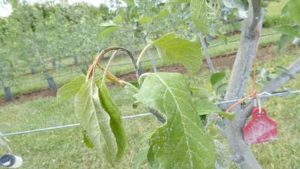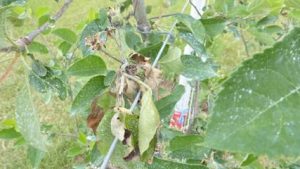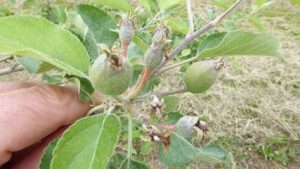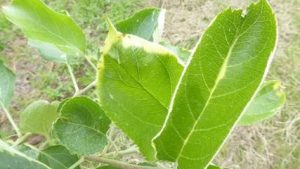Note: because I still cannot get my email program to post photos to this listserv, there will be references to pictures in the message below but nothing there. Growers who are very familiar with early fire blight symptoms should get out and inspect their orchards now; others might take the extra minute to view the pictures in the accompanying blog post at: http://blog.uvm.edu/fruit/2016/06/08/wet-weather-over-the-weekend-and-continuing/Fire-blight-symptoms-appearing-in-area-orchards
Fire blight symptoms are beginning to appear in area orchards where infection occurred. This first came to my attention when a grower from southern Vermont sent me a picture over the weekend for confirmation of whether or not the symptoms he was seeing were from fire blight. I’m still not sure that’s what we were looking at in that photo, but it’s entirely possible (and I’m beginning to think more likely).
Figure 1. Suspected fire blight on a shoot from southern Vermont.
Today I received notice from Eric Boire at CPS that growers in the Champlain Valley of New York are reporting shoot blight symptoms on susceptible cultivars: Cortland and Gala in particular. Cornell Extension Associate Anna Wallis has confirmed this and sent notice to area growers to be on alert. I immediately checked our organic orchard at the UVM Horticulture Research and Education Center and definitely saw symptoms of the disease.
Figure 2. Classic ‘shepherd’s crook’ symptom of shoot blight on Crimson Crisp at UVM HREC organic orchard.
Figure 3. Blossom blight symptoms shown on developing fruit.
As the name implies, symptoms look like tree shoots and / or fruit clusters were burned with a torch, although early symptoms may appear as water soaked tissues. A good fact sheet on symptoms and management may be found at: http://www.caf.wvu.edu/kearneysville/disease_descriptions/omblight.html
I did not see symptoms on trees that received streptomycin during bloom (strep is prohibited in certified organic orchards).
This is not a disease to underestimate, as, unlike most other tree fruit diseases which are fungal in nature, the bacterial pathogen associated with this disease enters the vascular system and can severely affect tree growth and production and even kill trees in a single season.
NOTE: It is CRITICAL that you not apply streptomycin to symptomatic trees in an attempt to manage the disease. You will NOT get control, and you will select for resistant strains of the bacteria.
Orchards should be scouted immediately for disease symptoms, and several courses of action should be considered. I will be referencing a 2014 post from Penn State Plant Pathologist Kari Peters for management considerations (found here). The primary courses of action are to cut the symptomatic tissue out of the tree, to reduce vegetative growth that is susceptible to shoot blight, and /or to spray a material with bactericidal activity (NOT STREP). A few notes:
1. If pruning out infections, only do so in dry weather and not within at least 8-12 (preferably 24) hours before rain, which could spread the bacteria throughout the orchard and increase infection. That shuts down most of this week for pruning.
2. When you do prune, cut shoots at least 8-12 inches below the extent of symptoms because bacteria can be present in vascular tissue below visibly affected regions. Focus on removing infected tissue and not saving this year’s crop- you’re saving the tree.
3. Concentrate first on susceptible cultivars like Gala, Honeycrisp, Cortland, Mutsu. A further list of relative cultivar susceptibility to disease may be found at: https://www.extension.purdue.edu/extmedia/BP/BP-132-W.pdf.
4. Young trees, especially on susceptible dwarfing rootstocks (M9, M 26, and others) will be most susceptible to tree damage or loss. Focus on them.
5. Application of Double Nickel (8 fl oz/100 gal dilute) plus Cueva (2 qt / 100 gallons dilute) fungicides have shown efficacy in reducing disease severity in past trials. These should be applied as soon as possible and repeated on 10-14 day intervals until shoot growth subsides. However, Cueva, a copper fungicide, may cause fruit russeting and should be applied in as concentrated a spray possible (low gallons per acre) and under good drying conditions, and not to wet fruit or foliage.
6. Shoot growth can be reduced by applying a high rate (8-12 oz/100 gallons) of Apogee now. Consider reapplying in 2-4 weeks if symptoms continue to appear and excessive growth continues.
All spray rates per 100 gallons are based on tree row volume calculations as referenced in the 2015 New England Tree Fruit Management Guide.
A couple of other considerations deserve mention. When scouting for infection, be careful not to over assess symptoms when you see fruit with yellowing stems, these are normal since we are still in the window where thinning practices will be apparent in the orchard.
Figure 4. Normal thinning response, the fruit with yellow stems will soon drop. This is not fire blight.
You also may note yellowing on leaves where streptomycin was applied during bloom. This is normal and will not greatly affect the tree, not anything like fire blight will.
Figure 5. Normal leaf burn symptoms from application of streptomycin during bloom.
Please let me know if you see symptoms of fire blight in your orchard, especially in orchards where strep was applied this year. I have a colleague interested in testing for strep-resistant strains of causal agent Erwinia amylovera, and I may be interested in collecting samples from affected orchards.





